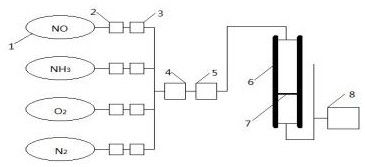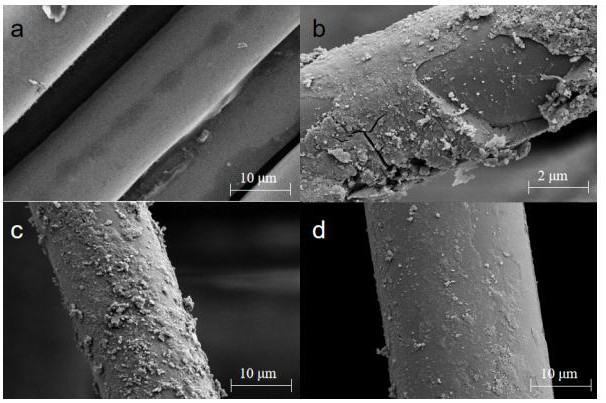Polyphenylene sulfide composite material and preparation method of in-situ supported sulfur-doped graphene denitrification and anti-sulfur catalyst
A technology of sulfur-doped graphene and composite materials, which is applied in the field of sulfur-doped graphene composite catalysts and filter materials, can solve the problems of the end of a difficult flue gas treatment system, a high catalyst activation temperature, and high installation and operation costs, and achieves a reaction The synthesis method and operation are simple, the reaction catalysis temperature is reduced, and the out-of-stock rate is high.
- Summary
- Abstract
- Description
- Claims
- Application Information
AI Technical Summary
Problems solved by technology
Method used
Image
Examples
Embodiment 1
[0040] Preparation of S-rGO: 1 g of graphite was added to a 150 mL beaker, 40 mL of concentrated sulfuric acid was added, and it was placed in a water bath and stirred at room temperature until fully dissolved. Add 0.2g of KMnO every 10min 4 , the amount of potassium permanganate added is 5g. KMnO 4 After all the additions were completed, the water temperature was raised to 50° C., and after stirring for 2 hours, the water temperature was raised to 80° C. to continue the reaction for 2 hours, and then 80 ml of deionized water was added. The reaction solution obtained in step (2) was placed in a 90 ° C water bath and stirred for 10 min, and H was added dropwise. 2 O 2 until there are no bubbles. Finally, 20 ml of hydrochloric acid was added, and the obtained product was repeatedly centrifuged until neutral. The product was diluted with 80 ml of deionized water, 0.5 g of m-bromothiophene and 0.3 g of thiophene-3-amine were added, fully dissolved, and then transferred to an ...
Embodiment 2
[0045] Preparation of S-rGO: 1 g of graphite was added to a 150 mL beaker, 40 mL of concentrated sulfuric acid was added, and it was placed in a water bath and stirred at room temperature until fully dissolved. Add 0.2g of KMnO every 10min 4 , the amount of potassium permanganate added is 5g. KMnO 4 After all the additions were completed, the water temperature was raised to 50° C., and after stirring for 2 hours, the water temperature was raised to 80° C. to continue the reaction for 2 hours, and then 80 ml of deionized water was added. The reaction solution obtained in step (2) was placed in a 90 ° C water bath and stirred for 10 min, and H was added dropwise. 2 O 2 until there are no bubbles. Finally, 20 ml of hydrochloric acid was added, and the obtained product was repeatedly centrifuged until neutral. The product was diluted with 80 ml of deionized water, 0.5 g of m-bromothiophene and 0.3 g of thiophene-3-amine were added, fully dissolved, and then transferred to an ...
Embodiment 3
[0050] Preparation of S-rGO: 1 g of graphite was added to a 150 mL beaker, 40 mL of concentrated sulfuric acid was added, and it was placed in a water bath and stirred at room temperature until fully dissolved. Add 0.2g of KMnO every 10min 4 , the amount of potassium permanganate added is 5g. KMnO 4 After all the additions were completed, the water temperature was raised to 50° C., and after stirring for 2 hours, the water temperature was raised to 80° C. to continue the reaction for 2 hours, and then 80 ml of deionized water was added. The reaction solution obtained in step (2) was placed in a 90 ° C water bath and stirred for 10 min, and H was added dropwise. 2 O 2 until there are no bubbles. Finally, 20 ml of hydrochloric acid was added, and the obtained product was repeatedly centrifuged until neutral. The product was diluted with 80 ml of deionized water, 0.5 g of m-bromothiophene and 0.3 g of thiophene-3-amine were added, fully dissolved, and then transferred to an ...
PUM
| Property | Measurement | Unit |
|---|---|---|
| radius | aaaaa | aaaaa |
| thickness | aaaaa | aaaaa |
| heat deflection temperature | aaaaa | aaaaa |
Abstract
Description
Claims
Application Information
 Login to View More
Login to View More - R&D
- Intellectual Property
- Life Sciences
- Materials
- Tech Scout
- Unparalleled Data Quality
- Higher Quality Content
- 60% Fewer Hallucinations
Browse by: Latest US Patents, China's latest patents, Technical Efficacy Thesaurus, Application Domain, Technology Topic, Popular Technical Reports.
© 2025 PatSnap. All rights reserved.Legal|Privacy policy|Modern Slavery Act Transparency Statement|Sitemap|About US| Contact US: help@patsnap.com



